Aligarh
| Aligarh अलीगढ़ |
|
| Mecca of Education | |
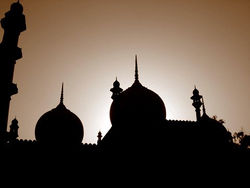 |
|
|
|
|
| Coordinates | |
| Country | |
| State | Uttar Pradesh |
| Division | Aligarh |
| District(s) | Aligarh |
| Population | 667,732 (2001[update]) |
| Time zone | IST (UTC+5:30) |
| Area |
• 178 metres (584 ft) |
Aligarh (pronunciation, Hindi: अलीगढ़, Urdu: علی گڑھ) is a city in Aligarh District in the northern Indian state of Uttar Pradesh. The city is located about 90 miles (140 km) southeast of New Delhi. It is the administrative headquarters of Aligarh District, Aligarh Police Range and Aligarh Division, and has a population of half a million. It is mostly known as a university town where the famous Aligarh Muslim University is located. The Aligarh division includes Aligarh, Etah, Hathras, and Kanshi Ram Nagar districts. Aligarh has one of the best educational institutes in India. It is popularly known as the 'Mecca of Education'.
Contents |
History
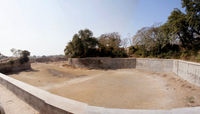
Aligarh was known by the earlier name of Kol or Koil before the 18th century.[1] The name Kol covered not only the city but the entire district, though its geographical limits kept changing from time to time. The origin of the name is obscure. In some ancient texts, Kol has been referred to in the sense of a tribe or caste, name of a place or mountain and name of a sage or demon. From the study of the place-names of the district, it appears that the district was once fairly well covered by forest, thickets and groves. The early history of the district, through the 12th century AD is obscure.[1] According to Edwin T. Atkinson, the name Kol was given to the city by Balarama, who slew here the great Asura (demon) Kol and with the assistance of the Ahirs subdued this part of the Doab.[2] In another account, Atkinson points out a "legend" that Kol was founded by the Dor tribe of Rajputs in 372 AD. This could be further confirmed by an old fort, the Dor fortress, now in ruins, which lies at the city's centre.
Some time before the Muslim invasion, Kol was held by the Dor Rajputs and in the time of Mahmud of Ghazni the chief of the Dors was Hardatta of Baran.[2] There is reason to believe that Kol was once the seat of a Buddhist community as statues of Buddha and other Buddhist remains have been found in excavations made in the eminence on which the citadel of Koil stood. It also had Hindu remains indicating that in all probability the citadel contained in succession a Buddhist and a Hindu temple.[2]
In 1194 AD, Qutb-ud-din Aybak marched from Delhi to Koil which was "one of the most celebrated fortresses of Hind".[2] Qutb-ud-din Aybak appointed Hisam-ud-din Ulbak as the first Muslim governor of Koil.[2]
Koil is also mentioned in Ibn Battuta's Rihla, when Ibn Battuta along with 15 ambassadors representing Ukhaantu Khan, the Mongol Emperor of the Yuan dynasty in China, traveled to Koil city en route to the coast at Cambay (in Gujarat) in 1341.[3] According to Ibn Battuta, it would appear that the district was then in a very disturbed state since the escort of the Emperor's embassy had to assist in relieving Jalali from an attacking body of Hindus and lost one of their officers in the fight. Ibn Batuta calls Koil "a fine town surrounded by mango groves". From these same groves the environs of Koil would appear to have acquired the name of Sabzabad or "the green country".[2]
In the reign of Akbar, Koil was made a Sirkar and included the dasturs of Marahra, Kol ba Haveli, Thana Farida and Akbarabad.[2] Both Akbar and Jahangir visited Kol on hunting expeditions. Jahangir clearly mentions the forest of Kol, where he killed wolves.[1]
During the time of Ibrahim Lodhi, Muhammad, son of Umar was the governor of Kol, built a fort at Kol and named the city after his own name as Muhammadgarh in 1524-25; and Sabit Khan who was the governor of this region during the time of Farrukh Siyar and Muhammad Shah, rebuilt the old Lodi fort and named the town after his own name Sabitgarh. The ruler of Koil was Bargujar King Rao Bahadur Singh whose ancestors ruled it from AD 1184 after the marriage of Raja of Koil Ajit Singh's daughter to Raja Pratp Singh Bargujar. In early 1753, the Bargujar Chief rose against the destruction of Hindu temples. The Jat ruler Surajmal in 1753, with patronage from Jai Singh of Jaipur and the Muslim army occupied the fort of Koil, the Bargujar Raja Bahadur Singh continued the battle from another fort under them and died fighting in what is known as the "Battle of Ghasera". All the women committed Jauhar. It was re-named Ramgarh and finally, when a Shia commander, Najaf Khan, captured Kol, he gave it its present name of Aligarh. Aligarh Fort (also called Aligarh Qila), as it stands today, was built by French engineers under the control of French officers Benoît de Boigne and Perron.[1]
Battle of Ally Ghur (1803)
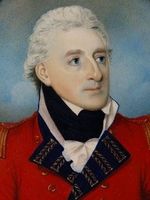
The Battle of Ally Ghur was fought on September 1, 1803 during the Second Anglo-Maratha War (1803–1805) at Aligarh Fort. The British 76th Regiment, now known as the Duke of Wellington's Regiment laid siege of the fort which was under first-rate French officer Perron and established British rule after overtaking the fort. In 1804, the Aligarh district was formed by the union of the second, third and fourth British divisions with the addition of Anupshahr from Moradabad and Sikandra Rao from Etawa. On the August 1, 1804, Mr Claude Russell was appointed the first Collector of the new district.[4]
Establishment of Aligarh Muslim University (1875)
In 1875, Sir Syed Ahmed Khan founded the Muhammadan Anglo Oriental College in Aligarh and patterned the college after Oxford and Cambridge universities that he had visited on a trip to England. This later became Aligarh Muslim University in 1920.
Geography
Aligarh is located at .[5] It has an average elevation of 178 metres (587 feet). The city is situated in the middle portion of Doab, or the land between the Ganges and Yamuna Rivers. The Grand Trunk Road passes through the city.
Climate
| Aligarh | ||||||||||||||||||||||||||||||||||||||||||||||||||||||||||||
|---|---|---|---|---|---|---|---|---|---|---|---|---|---|---|---|---|---|---|---|---|---|---|---|---|---|---|---|---|---|---|---|---|---|---|---|---|---|---|---|---|---|---|---|---|---|---|---|---|---|---|---|---|---|---|---|---|---|---|---|---|
| Climate chart () | ||||||||||||||||||||||||||||||||||||||||||||||||||||||||||||
|
||||||||||||||||||||||||||||||||||||||||||||||||||||||||||||
|
||||||||||||||||||||||||||||||||||||||||||||||||||||||||||||
Aligarh has a monsoon influenced humid subtropical climate, typical of north-central India. Summers, which start in April are hot with temperatures peaking in May. Average temperatures range between 28–33 °C (82–91 °F). The monsoon starts in late June, continuing till early October, with high humidity levels. Aligarh gets most of its annual rainfall of 800 millimetres (31 in) during these months. Temperatures then decrease, and winter starts in December, and continues till early February. Temperatures range between 12–16 °C (54–61 °F). Winters in Aligarh are generally mild, but fog and cold snaps may occur. The best time to visit Aligarh is during the months of February, March or November when temperatures are moderate and humidity low.
Demographics
As of the census[6] of 2001,[7] Aligarh had a population of 667,732. Males constitute 53% of the population and females 47%. Aligarh has an average literacy rate of 71%, higher than the national average of 65.4%; with 79% of the males and 61% of females literate. 16% of the population is under 6 years of age.
Near By Villages
Mangarhi - This is a village situated 20 km from Aligarh on the Aligarh Gonda road.
Gorai - It is located 39 kilometres from Aligarh and nearer to Mathura. Barauli Rao is situated nearly 24 km from Aligarh.
sidarmain - it is located on etah -aligarh border. it is famous for making moong malas.
Kasimpur Power House Colony & Village - it is located on Anupshare Road Near Jawa -aligarh border. it is famous for making Electricity Plan (Gov. U.P.).
Languages spoken
The main languages spoken in Aligarh are Hindi, English and Urdu. This is because the state Uttar Pradesh is a core of Hindi-Heartland.
The most spoken dialect of Hindi in Aligarh is Hindustani. Hindi is used more in the administrative fields.
Another popular language spoken in Aligarh is Brij Bhasha. This is the dialect that is spoken mainly by the rural population in Braj.
Industry
Aligarh City is famous as an industrial city. It is also known as Taala Nagari (Locks City of India). The second Largest Lock Manufacturer of Locks in India Link Locks is based in the City. An approximation puts the total number of industries at 25,000 which constitute of both Small scale & Large Scale Industries. Aligarh is having a boom in the construction business at this point of time, many new multi level buildings, shopping complexes and apartments have come up. Many malls are recently being constructed by major developers from Delhi & Aligarh. Malls in the city include Great Shopping Mall at Ramghat Road, Many more are under construction like The Landmark Mall at Marris Road, Sharda Mall at Center Point, Ozone Mall at Ring Road, Great Value Mall at Ramghat Road.
There are many popular showrooms of several internationally known clothing and sports brands in Aligarh. Uttar Pradesh State Industrial Development Corporation (UPSIDC) has developed Taala Nagri Industrial Area at Ramghat Road.
There are three Industrial Areas like Industrial Estate, Pala Road and Taala Nagari. Ahlampur Industrial Area has been proposed by UPSIDC at Delhi G.T Road. Dakshinanchal Vidyut Vitran Nigam Ltd. provides unrestricted power at Taala Nagari.
Aligarh is amongst the largest manufacturers and suppliers of locks and hardware goods in India and is also one of the largest manufacturers of brass fittings. It also a manufacturer of plastic and iron toy pistols, handcuffs, belts, badges for schools and government supply. It also has an artware and sculpture products Industry. It supplies products all over the world. Brass market of Aligarh is one of the largest in India, which employs thousands of skilled laborers. About 100 tonnes of brass and 50 tonnes of zinc is processed daily. Iron, aluminum, bronze, and zinc products are also manufactured in the city.
Aligarh is also a bulk producer of zinc die cast parts by hot chamber die casting process. These products are consumed in low end domestic market. Consumption of Zinc alloy in Aligarh is more than the consumption of zinc alloy in rest of India. Made in Aligarh Zinc die cast parts can get broken after 2 to 4 years as Aligarh uses recycled zinc alloy, which contains lot of impurities, specially lead.
Aligarh also has automobile parts industries which supply their products in India and abroad. It has four fruit ripening plants which ripens/preserves fruits, dry fruits and vegetables.
Economics
The city is an agricultural trade centre.[8] The processing of agricultural products and manufacturing are also important.[9]
Aligarh has always been an important business centre of Uttar Pradesh which is most famous for its locks industry. The locks that are produced in Aligarh are exported to different parts of the world. In 1870, Johnson & Co. was the first English locks firm to be set up in Aligarh. In 1890, Johnson & Co. initiated the manual production of locks on a small scale here.[10]
Being a railroad junction, Aligarh has developed into a commercial centre of an agricultural region which produces wheat, sugarcane, cotton, corn, barley, potato, guava and millet. In addition to the lock industry, the other industries of Aligarh include flour milling, processing of raw cotton and manufacture of butter, thermometer and glass.
Aligarh is also famous for its brass hardware and sculptures. Today, the city holds thousands of manufacturers, exporters and suppliers involved in the brass, bronze, iron and aluminium industries. M/s Plus Point Buildsware Pvt. Ltd. is one of the major Suppliers of Brass and other Building Fitting Items.
There is a thermal power station 15 km away from the city. It is called Harduaganj Thermal Power Station (also referred as Kasimpur Power House). A nuclear power station, Narora Atomic Power Station is located 50 km away from Aligarh.
Despite its proximity to two large power stations, frequent power cuts are normal in Aligarh. They are not just frequent but more than enough to creat havoc. Now the situation is like that people are trying to generate their own power using generators and invertors. It is not uncommon in the summers to have 10 hours or more of power cuts every day. Aligarh also boasts of a Heinz-sauce manufacturing unit in Manzurgarhi (around 15 km from Aligarh). Aligarh is also popular for its sugar factory, Satha sugar factory is just 12 km far from the centre of city. Satha sugar factory is located at Aligarh Kasimpur route. On this route one Cement factory is also on its way. few leading printers : aligarh digital press.
Education
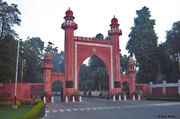
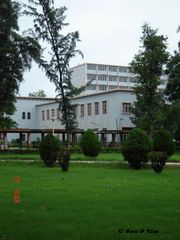
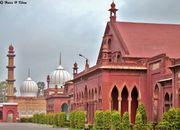
Aligarh is a city of Uttar Pradesh that is held in high esteem for the educational facilities offered here. The Aligarh Muslim University, a residential academic institution having an international repute, is found spread across the city civil lines area.
There are more than 250 courses offered in the Aligarh Muslim University in both traditional and modern fields of education. Aligarh Muslim University was built following the pattern of Cambridge and Oxford in 1920. Mangalayatan University, founded by the renowned philanthropist, social worker and journalist Pawan Jain, is also set up in Aligarh.[11]
Other famous schools/ colleges/ institutes of Aligarh are:
- M.M.Presidency Girls Inter College, Khair byepass Road, Aligarh. Ph-9837109853
- St. Fidelis
- Ayesha Tarin Modern Public School(+2), P.O. CDF
- Three Dots Senior Secondary School
- Our Lady of Fatima Secondary School
- A.M.U City High School
- Delhi Public School
- Gagan Public Senior Secondary School
- Krishna International School
- Blue Bird Senior Secondary School
- Al-Barkaat Public School (10+2)
- Aligarh Public School
- Moonup Infotech, Aligarh
- Heritage International School (Tala Nagari & Premier Nagar)
- Hare Krishna Public School
- Raghuveer Bal Mandir
- Ingraham Institute
- Shri Varshney College, Aligarh.
- Saraswati Vidya Mandir, Gonda Mod, Khair Road, Aligarh
- D.S. Degree College
- T.R. Girls College
- Hiralal Barahseni Inter College.
- Indian Institute Of Medical Representative (Iimr)
- Institute Of Information Management Technology (Iimt)
- Shivadan Singh Institute of Technology and Management (SSITM)
- Aligarh College Of Engineering & Technology (Acet)
- Aligarh College Of Engineering And Management (Acem)
- S.T.High School (Minto Circle)
- Taameer-E-Millat Islamia School, Dodhpur
- Albarkat Institute Of Management (Anoop Shehar Road)
- Zakir Hussain Sr Sec School
- Saraswati Vidhya Mandir, Mathura Road, Asana Ajeetpur Aligarh.
- H.B. Inter College
- Babu Lal Jain Inter College, Jain Puri
- Sri Sai Ayurvedic College
- Iqra Public School
- Naurangi Lal Govt. Inter College
- Jagdish Bal Mandir, Rajendra Nagar
- Neel Giri Inter College, Agra Road
- Raghuveer Sahay Inter Collage
- Dazzling Public School, R. K. Puram, Agra Road & Gabhana, Aligarh-Delhi Highway.
- Mangalaaytan University, Aligarh Mathura Road and many more....
- Vishwa Bharti Public School Sasni Gate Aligarh
- Dayanand saraswati vidhya mandir kasimpur Aligarh
- Eurokid's Aligarh [12]
- JAMIA URDU ( DISTANCE OPEN UNIVERSITY ) FOR URDU PROMOTION
- AL-FALAH PUBLIC SCHOOL, NAGLA MASANI
- Jagran Public School,Mathura Road
- Firdaus Public School
Important places
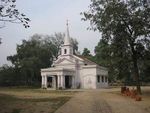
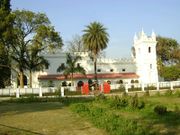
There are two popular landmarks in Aligarh. One is Aligarh fort and another is Sir Syed Masjid in Aligarh Muslim University's campus. Another old fort, the Dor fortress (1524), now in ruins, lies at the city's centre; its site is located in the area now called Upper Kot and is occupied by an 18th-century mosque. The city also contains tombs of Muslim saints.[13]
Aligarh has a very renowned tomb (Baba Barchi) at Kath Pula. One famous Jainism Teerth Dhaam "Mangalayatan Teerth Dhaam" has been built at Agra Road. Another old Jain temple with fresco painted ceilings is located behind Khirni Gate Police Chowky at Agra Road in the main City.
"Ibn Sina Academy of Medieval Medicine and Sciences".[14] at Tijara House is another site-seeing place where one can see a huge library on history of medicine and history of science.[15] and a museum on Indian heritage and culture. It was built by a Unani Physician and philanthropist Hakim Syed Zillur Rahman.
The Annual Cultural Exhibition, popularly known as numaish, held at the Exhibition ground is held in January and February. Aligarh is also famous for Sherwanis, especially the Mehndi Hasan's shop reportedly frequented by former Prime Minister of India Pandit Nehru.
There are few churches in Aligarh .Quite famous are Church Of Ascension ,Christ Church and The Methodist Church.
Markets
Some of the more famous markets of Aligarh include the Center Point Market, Railway Road market, Shamshad market, Mahavir Ganj, Upper Fort (known as Uppar Kot),Tasveer Mahal and Amir Nisha. Center Point Market is the best place for shopping for brand freaks. All major brand outlets are in the vicinity of this market.Recently, brands like Adidas,Puma have opened their outlets here. Railway Road and Amir Nisha markets are the major shopping hubs with a variety of clothes, cosmetics, jewellery and footwear being sold. Shamshad market and Achal Tal market are noted for its educational book stores. Mahavir Ganj is mostly famous for grocery items like Ghee, spices, dry fruits, pulses, etc.
Most markets in Aligarh are made up of many small shops and markets can get very crowded during daytime because the Roads are very Narrow. Cars and Cycle rickshaws often clog up streets leading to traffic jams that can last well more than an hour or so.
Cineplexes
Aligarh has many movie theatres such as Grand Surjit, Vadra Big Cinemas (Adlabs), Meenakshi (only cinema having pure Dolby Digital Sounds), Nandan, Lakshmi, Nishat, Tasveer Mahal and Novelty.
Important residential places
The city is divided into two areas known as Old Aligarh (City) and New Aligarh (Civil Lines).
New Aligarh
It consists of Church Compound,Jamalpur,Hamdard Nagar Block- A,B,C & D, Tayyab colony, Lal Diggi Road,Begam Bagh, Anwarul Huda Compound, Amir Nisha, Azim Compound, Zakaria Market, Dhorra Mafi (have its occurrence in the Guinness book, for the most educated & Developed Village of Asia), Sir Syed Nagar (on the name of sir syed ahmad khan ,and have its occurrence in the Guinness book,for the most educated colony of Asia, info by ARHAM KHAN), Friends Colony, New Jamalpur, Hamdard Nagar B,Badar Bagh, Habib Bagh, Bhamola, Zohrabagh,Ghalib Bagh, Dodhpur, Shabistan Compound, Jeevangarh, Kela Nagar, Firdaus Nagar,Firdous Complex, Kabir Colony, Janakpuri, Professor Colony, Prag Sarover, Gyan sarover (with 100 ft road), Maan sarover, Avantika-1 and 2, Quarsi, Swarna Jayanti Nagar, Shyam Nagar,Janakpuri, Vikram Colony, Medical Colony, Lekhraj Nagar, Ramesh Vihar Colony, Durga Badi, Marris Road, Vidhya Nagar, Ram Krishna Puram, Sasni Gate, Delhi GT Road and many more new colonies are developed by Aligarh Development Authority, Vidyut Nagar Colony on G.T Road.
Old Aligarh
Kapil Vihar Colony, Banna Devi Police Colony, Kishanpur,Bhamola,Anona House, Pahasu House, Rasalgunj Gambhir Pura, Mahendra Nagar, Surendra Nagar, Bank Colony (Premier Nagar), Gandhi Nagar, Saray Sultani, Achal Talab and Khirni Gate are some of the residential areas in old Aligarh. Green Park Colony near SBBM Inter College is a new constructed colony.
Media
Aligarh currently has 2 FM Radio stations:
- 92.7 MHz Big FM
- 101.3 MHz All India Radio,
Qawwal Habib Painter is from Old City of Aligarh, Many popular Bollywood artists hail from Aligarh. Some of them are Chandra Choor Singh, Sunidhi Chauhan, Faheem uddin, Naseeruddin Shah, Ravindra Jain and Javed Akhtar. Kaka Hathrasi was also from Aligarh (Hathras, now Distt. Maha Maya Nagar was earlier Sub District of Aligarh). Bharat Bhushan the bollywood super star of 1950s was born in Aligarh.
Transport
Aligarh is well connected to the other cities. India's Longest Road, G.T Road passes through Aligarh. The nearest airport is the Indira Gandhi International airport which is about 160 km away. By road, Aligarh is well-connected to Delhi, Noida, Greater Noida, Faridabad, Ghaziabad, Agra, Mathura, Meerut, etc. A large number of people commute to Delhi, Noida, Greater Noida, Ghaziabad and Gurgaon every day for work. Two national highway (NH-91, NH-93) pass through Aligarh. An expressway from Delhi to Agra called Yamuna Expressway is under development which passes through Aligarh.
There are 2 main bus terminals Masoodabad Bus Terminal and Gandhi Park Bus Terminal from where Uttar Pradesh State Road Transport Corporation (UPSRTC) buses serve cities all over the state of Uttar Pradesh and many other cities in Uttranchal, Rajasthan, Madhya Pradesh and Haryana. Aligarh has a railway Station called Aligarh Junction. It connects Aligarh to the West Bengal, Orissa, Bihar, Jharkhand, North East and most of Uttar Pradesh. Junction runs about 70 daily Mail/ Express/ E.M.U Trains. It connects the city to important places such as New Delhi, Mumbai, Kolkata, Bhopal, Gwalior, Lucknow, Jhansi, Puri, Kanpur, Agra, Varanasi and Jaipur.
City buses, tempos and rickshaw are convenient options to commute within the city.
An international airport of Delhi has been approved by the Government in Jewar which also comes in Aligarh's District Range and far away about 70 km by road. The Metro Rail Project has been passed and by 2014 it will be running in the city of Aligarh. Other new projects have already been passed like Inner Ring road, Outer Ring road by Central Government and construction of a new flyover. An airport has also been approved by the Government.
References
- ↑ 1.0 1.1 1.2 1.3 History of Aligarh
- ↑ 2.0 2.1 2.2 2.3 2.4 2.5 2.6 DESCRIPTIVE AND HISTORICAL ACCOUNT OF THE ALIGARH DISTRICT By EDWIN T. ATKINSON, page 484
- ↑ The Adventures of Ibn Battuta, by Ross E. Dunn, p. 215
- ↑ DESCRIPTIVE AND HISTORICAL ACCOUNT OF THE ALIGARH DISTRICT By EDWIN T. ATKINSON, p. 348
- ↑ Falling Rain Genomics, Inc - Aligarh
- ↑ "Census of India 2001: Data from the 2001 Census, including cities, villages and towns (Provisional)". Census Commission of India. Archived from the original on 2004-06-16. http://web.archive.org/web/20040616075334/http://www.censusindia.net/results/town.php?stad=A&state5=999. Retrieved 2008-11-01.
- ↑ Census of India 2001
- ↑ India9.com
- ↑ Britannica
- ↑ Times of India
- ↑ Mangalayatan University
- ↑ Eurokid school
- ↑ Britannica India, by Dale Hoiberg, Indu Ramchandani
- ↑ [1]
- ↑ [2]
Further reading
- Aligarh in My Days (Interviews of former Vice Chancellors of Aligarh Muslim University), Ed. Syed Ziaur Rahman, Non-Resident Students’ Centre, Aligarh Muslim University, Aligarh, 1997.
External links
- Site for connecting Aligs
- Aligarh's Web portal
- Aligarh.Com
- Sudha enterprises
- Aligarh fully Yellopage Directory
- Domain Booking Website
- JantaReview Aligarh site
- Aligarh Muslim University
- Ibn Sina Academy of Medieval Medicine & Sciences, Aligarh
- DESCRIPTIVE AND HISTORICAL ACCOUNT OF THE ALIGARH DISTRICT by EDWIN T. ATKINSON
|
||||||||
|
||||||||||||||||||||
|
||||||||||||||||||||||||||||||||

